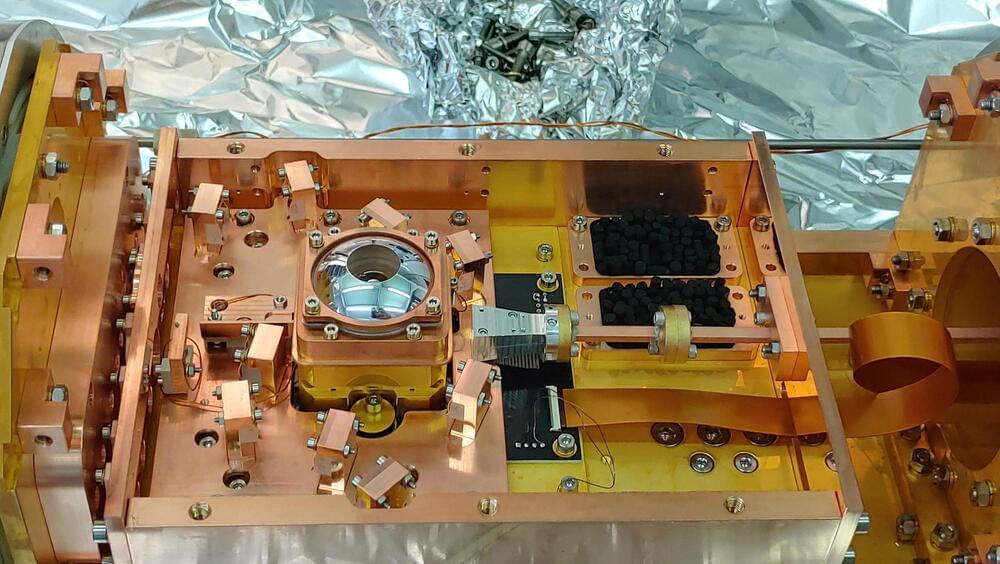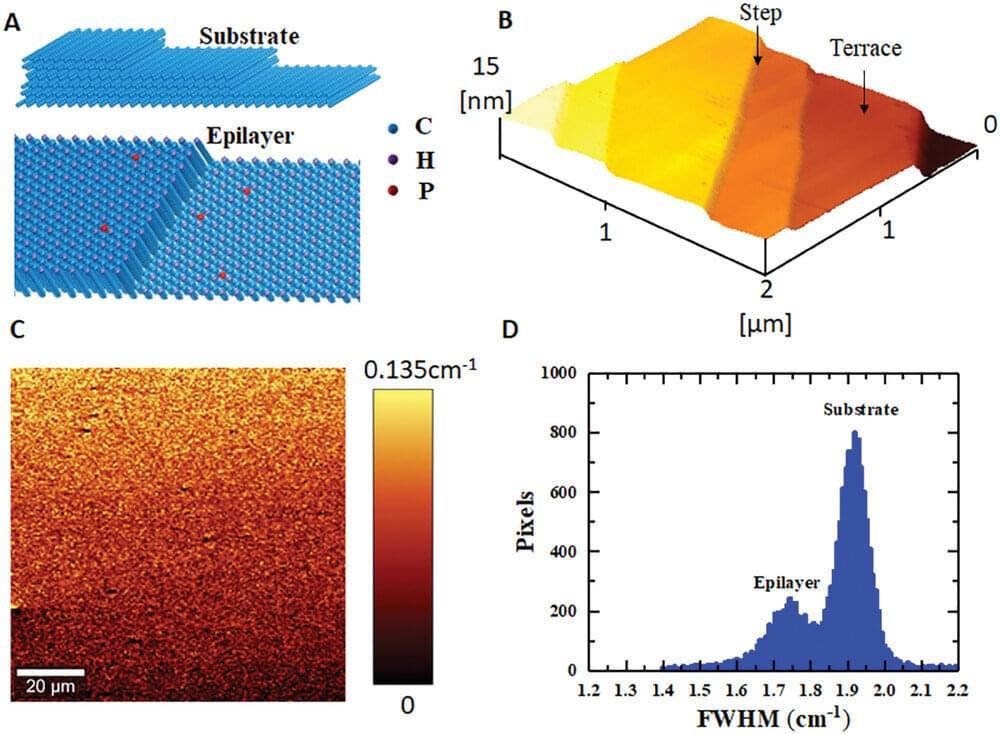Archive for the ‘computing’ category: Page 114
Apr 1, 2024
Quantum Computing Recharged With Electromagnetic Ion Trap Innovation
Posted by Saúl Morales Rodriguéz in categories: computing, quantum physics
Researchers at ETH have managed to trap ions using static electric and magnetic fields and to perform quantum operations on them. In the future, such traps could be used to realize quantum computers with far more quantum bits than have been possible up to now.
Apr 1, 2024
Metamaterials for Analog Optical Computing
Posted by Saúl Morales Rodriguéz in categories: computing, materials
Novel metamaterial-based architectures offer a promising platform for building mass-producible, reprogrammable schemes that perform computing tasks with light.
Apr 1, 2024
A New Source for Quantum Light
Posted by Saúl Morales Rodriguéz in categories: computing, encryption, quantum physics
A new device consisting of a semiconductor ring produces pairs of entangled photons that could be used in a photonic quantum processor.
Quantum light sources produce entangled pairs of photons that can be used in quantum computing and cryptography. A new experiment has demonstrated a quantum light source made from the semiconductor gallium nitride. This material provides a versatile platform for device fabrication, having previously been used for on-chip lasers, detectors, and waveguides. Combined with these other optical components, the new quantum light source opens up the potential to construct a complex quantum circuit, such as a photonic quantum processor, on a single chip.
Quantum optics is a rapidly advancing field, with many experiments using photons to carry quantum information and perform quantum computations. However, for optical systems to compete with other quantum information technologies, quantum-optics devices will need to be shrunk from tabletop size to microchip size. An important step in this transformation is the development of quantum light generation on a semiconductor chip. Several research teams have managed this feat using materials such as gallium aluminum arsenide, indium phosphide, and silicon carbide. And yet a fully integrated photonic circuit will require a range of components in addition to quantum light sources.
Mar 31, 2024
Building Molecular Circuits with DNA
Posted by Dan Breeden in categories: computing, electronics
Diodes, also known as rectifiers, are a basic component of modern electronics. As we work to create smaller, more powerful and more energy-efficient electronic devices, reducing the size of diodes is a major objective. Recently, a research team from the University of Georgia developed the world’s smallest diode using a single DNA molecule. This diode is so small that it cannot be seen by conventional microscopes.
A diode is an electrical device that allows current to move through it in one direction much more easily than the other. No diode prevents 100% of current flow in one direction while allowing unlimited current in the other direction—in reality, a diode will always allow some current in both the “forward” and “backward” directions. The larger the imbalance favoring the “forward” direction, however, the better diode we have. Diodes are responsible for controlling the current in many common electronic components. Millions of diodes are embedded in a single silicon chip, and to increase the processing power of these chips, the diodes need to be made smaller.
Following a prediction originally made in 1965 by Intel co-founder Gordon Moore, now known as Moore’s law, scientists and engineers have been able to make smaller and smaller computer hardware by doubling the number of electronic components in a silicon chip every 18 months. These improvements in computing power are approaching the physical limits of silicon, however; when silicon components are too small, they will become unstable and their performance unpredictable.
Mar 31, 2024
Quantum Gravity Breaks Causality — And You Can Compute With It
Posted by Dan Breeden in categories: computing, open access, quantum physics

Check out my course about quantum mechanics on Brilliant! First 30 days are free and 20% off the annual premium subscription when you use our link ➜ https://brilliant.org/sabine.
If you flip a light switch, the light will turn on. A cause and its effect. Simple enough… until quantum gravity come into play. Once you add quantum gravity, lights can turn on and make switches flip. And some physicists think that this could help build better computers. Why does quantum physics make causality so strange? And how can we use quantum gravity to build faster computers? Let’s have a look.
Continue reading “Quantum Gravity Breaks Causality — And You Can Compute With It” »
Mar 31, 2024
Physicist says his study supports computer simulation theory
Posted by Dan Breeden in categories: biological, computing, neuroscience
Very interesting article.
Now a physicist working at the University of Portsmouth in the UK has published research in the AIP Advances journal that he says provides support to the strange theory.
“I don’t want to paraphrase Morpheus from The Matrix but he said ‘what is real?’” the Associate Professor of Physics, Dr Melvin Vopson, said.
Continue reading “Physicist says his study supports computer simulation theory” »
Mar 31, 2024
World’s first N-Channel Diamond Field-Effect Transistor for CMOS Integrated Circuits
Posted by Natalie Chan in categories: computing, nuclear energy
A National Institute for Materials Science (NIMS) research team has developed the world’s first n-channel diamond MOSFET (metal-oxide-semiconductor field-effect transistor). The developed n-channel diamond MOSFET provides a key step toward CMOS (complementary metal-oxide-semiconductor: one of the most popular technologies in the computer chip) integrated circuits for harsh environment applications, as well as the development of diamond power electronics. The research is published in Advanced Science.
Semiconductor diamond has outstanding physical properties such as ultra wide-bandgap energy of 5.5 eV, high carriers mobilities, and high thermal conductivity, which is promising for the applications under extreme environmental conditions with high performance and high reliability, such as the environments with high temperatures and high levels of radiation (e.g., in proximity to nuclear reactor cores).
By using diamond electronics, not only can the thermal management demand for conventional semiconductors be alleviated but these devices are also more energy efficient and can endure much higher breakdown voltages and harsh environments.
Mar 31, 2024
Will Liquid Circuits Make Brain-Imitating Computers?
Posted by Dan Breeden in categories: computing, neuroscience
When a positive voltage was applied to the chip, the ions flowed to the pore, where their pressure created a blister between the chip’s surface and the graphite layer. When the blister forced the graphite upward, the device became more conductive, switching its memory state to “on.” Since the graphite stayed lifted even without a current, the chip essentially remembered this state, A negative voltage could pull the chip’s layers back together, resetting the device to its “off” state.
The scientists were able to connect two of these chips to form a logic gate —a circuit that can implement logical operations such as AND, OR, and NOT. They note they can build any other classical logic gate commonly employed in digital computing using their logic gate. This is the first time multiple fluidic memristors have been connected to form a circuit.
Previously, scientists developed fluidic memristors based on tiny syringes or microscopic slits. However, these earlier devices were too bulky and complex to scale up to larger systems. In contrast, the new microchips are compact and scalable, Emmerich says.
Mar 31, 2024
How Is Flocking Like Computing?
Posted by Dan Breeden in categories: biological, computing, food, physics
Birds flock. Locusts swarm. Fish school. Within assemblies of organisms that seem as though they could get chaotic, order somehow emerges. The collective behaviors of animals differ in their details from one species to another, but they largely adhere to principles of collective motion that physicists have worked out over centuries. Now, using technologies that only recently became available, researchers have been able to study these patterns of behavior more closely than ever before.
In this episode, the evolutionary ecologist Iain Couzin talks with co-host Steven Strogatz about how and why animals exhibit collective behaviors, flocking as a form of biological computation, and some of the hidden fitness advantages of living as part of a self-organized group rather than as an individual. They also discuss how an improved understanding of swarming pests such as locusts could help to protect global food security.
Listen on Apple Podcasts, Spotify, Google Podcasts, TuneIn or your favorite podcasting app, or you can stream it from Quanta.
















